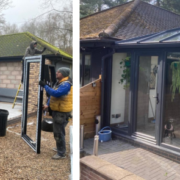Conservatory too cold? Here’s how to make a conservatory warmer all year round
Is your beautiful conservatory becoming a chilly no-go zone for much of the year? You’re not alone! Many homeowners dream of a light-filled extra living space, only to find their conservatory becomes a cold conservatory in winter and sometimes even on cooler summer days. But don’t despair – there are many effective ways to learn how to make conservatory warmer and transform it into a cosy, inviting area you can enjoy throughout every season. Let’s explore how you can make a conservatory warmer and finally achieve that sought-after warm conservatory.
Why do conservatories get so cold?
To understand how to keep a conservatory warm, it’s helpful to know why they lose heat so easily in the first place. Their design, primarily built from glass or polycarbonate, makes them susceptible to rapid temperature changes.
Wear and tear of materials
Over time, the seals around windows and doors can degrade, leading to small gaps. Gaskets might shrink or crack, reducing their effectiveness. Even the frame materials themselves can expand and contract, causing minor separations that allow cold air to seep in and warm air to escape. This wear and tear is a common culprit behind a cold conservatory.
Polycarbonate or glass roofs
While fantastic for letting in light, both polycarbonate and standard glass roofs are poor insulators compared to solid walls. Polycarbonate, especially older types, offers limited thermal resistance, allowing heat to escape rapidly. Standard glass, even if double-glazed, is much less insulating than a solid roof, contributing significantly to heat loss and making it difficult to keep a conservatory warm.
Single glazing
Many older conservatories were built with single-glazed windows. Single panes of glass offer almost no barrier to heat transfer. Warm air rushes out, and cold air rushes in, making your conservatory feel like an icebox in winter. Upgrading this is often a key part of how to keep a conservatory warm in the winter.
Poor insulation
Beyond the glazing and roof, the overall construction of some conservatories, particularly older models, might lack adequate insulation in the frames, dwarf walls, or even the floor. This general lack of thermal barriers means your heating efforts are quickly lost to the outside, perpetually leaving you wondering how to make conservatory warmer.
How to make your conservatory warmer
Now for the good news! There are numerous strategies, from simple fixes to more significant upgrades, that can help you understand how to make your conservatory warmer.
Install blinds
One of the simplest yet most effective solutions is installing good quality blinds. Cellular or thermal blinds create an extra layer of insulation at your windows and doors, trapping air and reducing heat loss. They also offer excellent shading in summer, preventing overheating.
Invest in a portable heater
For an immediate boost of warmth, a portable electric heater can be very effective for smaller conservatories or for targeted heating. Opt for energy-efficient models with thermostats to control temperature and running costs. Infrared heaters can also be very effective for direct heating without heating all the air in the room.
How much does it cost to run a portable heater?
Portable heaters can be a convenient way to add warmth to a specific room or area, especially if you don’t want to heat your entire home. However, it’s easy for the costs to add up if you’re not mindful of how much energy they consume. The running cost of a portable heater isn’t a fixed amount; it depends on several key factors, including the heater’s wattage, the type of heater, how long and often it’s used, and your electricity tariff. Understanding these elements can help you make informed decisions and manage heating your conservatory effectively.
Stop draughts in your conservatory
Draughts are notorious for making a room feel colder than it is. Check around windows, doors, and even electrical outlets for gaps. Use draught excluders for doors, apply weatherstripping to window frames, and seal any small cracks with appropriate sealant. This small step can make a big difference in how to keep a conservatory warm.
Consider upgrading to double-glazing
If your conservatory still has single-glazed windows, upgrading to modern double-glazing is a significant step towards improving thermal efficiency. Double-glazed units have a gap (often filled with inert gas) between two panes of glass, which acts as an insulating barrier, drastically reducing heat loss.
What’s the warmest flooring for a conservatory?
The right flooring can play a role in making a warm conservatory. Options like carpet, thick rugs, or insulated vinyl can add an extra layer of insulation compared to cold tiles or stone. Underfloor heating, while a larger investment, provides excellent, even warmth and makes any flooring type feel cosy.
Replace the roof
Perhaps the most impactful upgrade for a cold conservatory is replacing an old polycarbonate or glass roof with a modern, insulated solid or tiled roof. These roofs offer superior thermal performance, effectively turning your conservatory into a true extension of your home. They can drastically improve how to keep a conservatory warm in the winter and make the space usable year-round. Alternatively, modern high-performance glass roofs with enhanced thermal properties can also be a great option for balancing light and warmth.
How much does it cost to heat a conservatory?
The cost to heat a conservatory varies wildly depending on its size, level of insulation, the type of heating used, and current energy prices. An uninsulated, single-glazed conservatory will be very expensive to heat, as warmth escapes almost immediately. A well-insulated conservatory with modern double-glazing and a solid roof will be much more energy-efficient and therefore cheaper to keep warm. Investing in insulation upgrades often pays for itself in reduced heating bills over time
Insulating your conservatory
Beyond the roof and glazing, consider other insulation options. You can insulate the dwarf walls (if applicable) during construction or renovation. For existing conservatories, internal wall insulation can sometimes be added. Even simple measures like thick curtains or thermal blinds, as mentioned, contribute significantly to the overall insulation strategy, helping you master how to make conservatory warmer.
How to make your conservatory usable all year round
Transforming your chilly conservatory into a welcoming, year-round space is entirely achievable. By implementing a combination of these strategies – tackling draughts, upgrading glazing, or considering a new, more insulated roof and even underfloor heating – you can make your conservatory a truly integral and comfortable part of your home.
Ready to explore options for a warmer, more inviting conservatory? Visit Select Windows to see how a new conservatory roof or an entirely new conservatory could transform your home.











